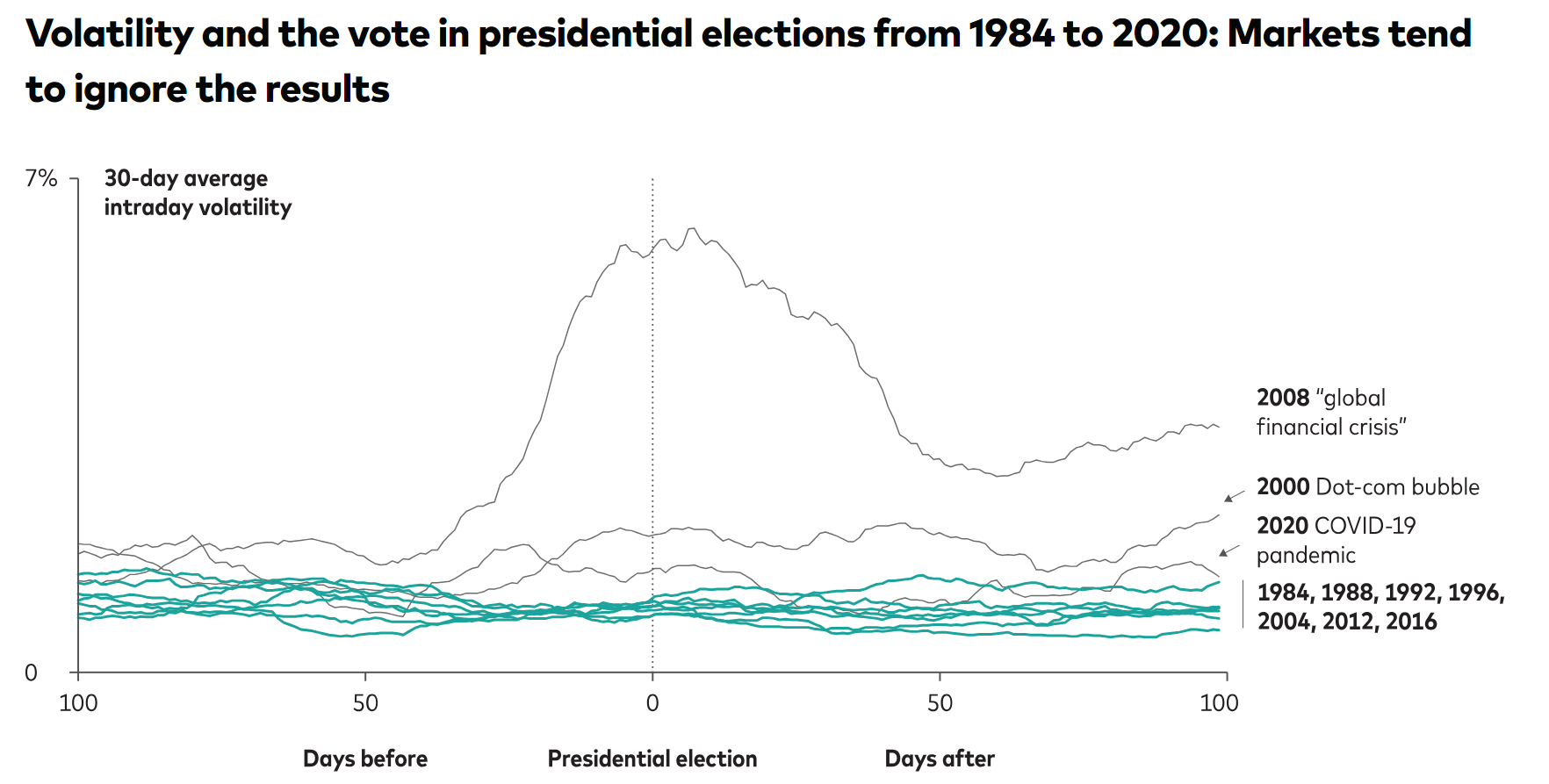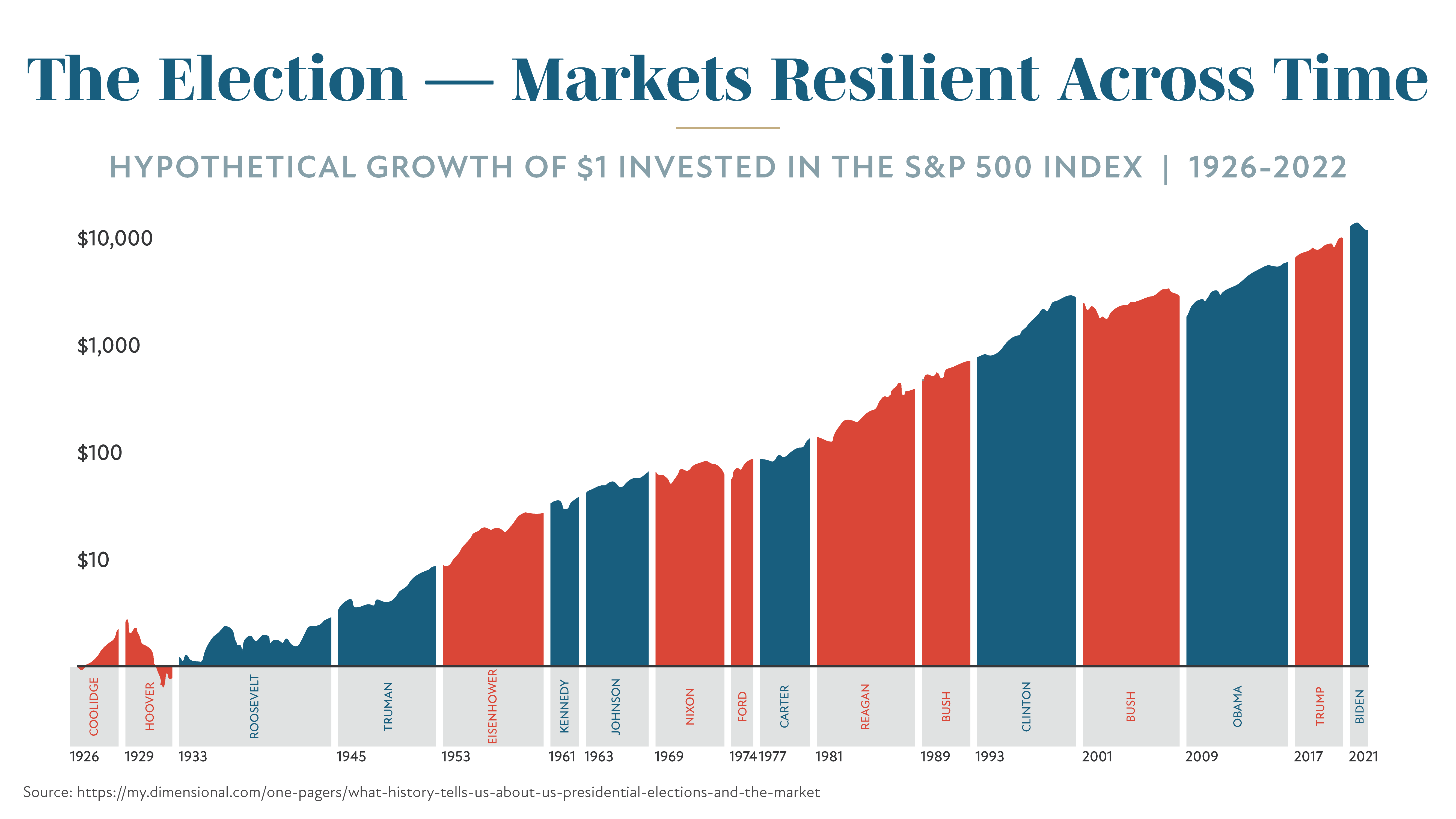4 Common Mistakes and How to Avoid Them
Election years bring a lot of uncertainty, and in a polarized political climate it can be easy to get bogged down by fear. Many investors worry about how the outcome of this year’s presidential election may impact their portfolios.
You may wonder:
- Will the markets tank if a certain candidate is elected?
- What asset classes will be most impacted?
- Will there be market chaos following the election?
Fortunately, past experience shows us that presidential elections tend to have a minimal impact on investors’ long-term returns. In fact, election years often offer investment opportunities for savvy investors who remain true to their long-term objectives.
As we continue to prepare for the 2024 election, it’s important to avoid making the following investing mistakes.
Mistake #1 – Worrying too much about potential market volatility.
While it’s true markets have historically experienced a certain amount of volatility during election years, that volatility typically has less of an impact than many investors expect.
To illustrate, consider the chart below, which tracks market performance across presidential election years from 1984 through 2020. Notice the annual volatility of the S&P 500 Index averaged 16.5% during the 100 days before an election and 15.9% the 100 days following an election. Both these averages are lower than the 17.9% annualized volatility over the complete time frame, which illustrates that the market performs independently of election cycles.

Source: Vanguard calculations, based on data from Global Financial Data (GFD) as of December 31, 2022. See link for additional information: https://investor.vanguard.com/investor-resources-education/article/presidential-elections-matter-but-not-so-much-when-it-comes-to-your-investments. This chart shows market volatility in the 100 days before and after presidential elections held between 1984 and 2020. In 1984, 1988, 1992, 1996, 2004, 2012 and 2016, the markets were less volatile than in 2020, 2000 and 2008. The most volatile year was 2008, with market volatility rising steeply around 50 days before the election and dropping steeply around 50 days after the election.
Mistake #2 – Missing out on investment opportunities.
Another common mistake made by many investors is reallocating to a more conservative investment portfolio during an election year. In the chart below, notice the difference in net fund flows during a presidential election year versus the year following a presidential election.
Those investors who implemented a more conservative allocation may have missed significant opportunities.
For example, consider historic market performance throughout presidential election years. As indicated in the chart below, performance typically starts out slow in the first half of a presidential year and accelerates significantly in the second half of the year.
If you were one of the investors who allocated heavily to money market funds leading up to the election, you’d have missed out on a significant growth opportunity in the latter part of the year.
Mistake #3 – Believing capital markets care about politics.
While you may have concerns about the future of our country if a certain political candidate is in the White House, capital markets don’t care about politics. In fact, the markets care about only one thing — future earnings.
The table below shows returns associated with different combinations of political parties controlling the White House and Congress. Notice that a full sweep of both the White House and Congress has less likelihood of causing market disruption than certain divided-government scenarios.
It is important to note that future earnings are impacted by policy decisions, and the administration (including the president, House and Senate) influences policy. If you’re concerned about the markets, rather than worrying about who’s in the White House, you may be wise to monitor the following policy issues:
- Individual and corporate tax rates
- International conflicts
- Immigration policy
- Spending priorities
- Trade agreements
- Healthcare
- Government regulations
Mistake #4 – Sacrificing long-term returns over worries about short-term volatility.
When it comes to investing, one of the biggest mistakes many people make is allowing fear or uncertainty to influence their decisions.
When speaking about market volatility, Creative Planning CEO Peter Mallouk often asks audience members the question, “What’s one thing all bear markets have in common?” The answer to his question is, “They all eventually end.”
To illustrate Peter’s point, notice in the following chart how markets continue to rise over time, regardless of the political party in power.

This visual shows the hypothetical growth of $1 invested in the S&P 500 Index between 1926 and 2021, which trends upward overall (ending near $10,000) despite which president was in office during any particular period and despite that president’s political party.
Also consider the following chart, which illustrates how missing just a few days in the market over many years can greatly impact a portfolio’s long-term performance.
In a nutshell, making fear-driven changes to your investment portfolio has the potential to result in irreparable long-term damage, because you risk selling at a loss and missing out on the eventual recovery. A better plan is to take a long-term approach to investing that allows you to remain invested through periods of political uncertainty.
The bottom line
Elections are important, and the president of the United States can have a significant impact on the policies that govern our lives. However, capital markets care little about which president occupies the White House, and investors who make fear-based decisions during an election year have the potential to miss significant opportunities over the long term.
Rather than letting uncertainty drive your investment decisions, consider investing in diversified portfolio that’s in line with your goals, risk tolerance, investment timeline and overall financial situation. In other words, don’t let your political concerns derail your long-term investment strategy.
If you could use help developing a long-term investment portfolio to weather future market volatility, we’d love to have a conversation. Please schedule a call with a member of our team.



